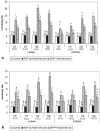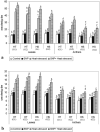Nitric oxide secures reproductive efficiency in heat-stressed lentil (Lens culinaris Medik.) plants by enhancing the photosynthetic ability to improve yield traits
- PMID: 34924710
- PMCID: PMC8639968
- DOI: 10.1007/s12298-021-01098-9
Nitric oxide secures reproductive efficiency in heat-stressed lentil (Lens culinaris Medik.) plants by enhancing the photosynthetic ability to improve yield traits
Abstract
Rising temperatures, globally and locally, would be detrimental for cool- and summer-season food legumes, such as lentil (Lens culinaris Medik.). Lentil is highly sensitive to supra-optimal temperatures (> 30 °C), particularly during reproductive growth, resulting in flower and pod losses. Thus, suitable strategies are needed to introduce heat tolerance in this legume. Here, we evaluated the efficacy of nitric oxide (NO)-applied as foliar treatment of 1 mM sodium nitroprusside (SNP), twice (one day before final exposure to high temperature, and again five days later)-on heat-stressed (32/20 °C) lentil genotypes, differing in heat sensitivity. As a result of heat stress, endogenous NO increased significantly in heat-tolerant genotypes (46-62% in leaves and 66-68% in anthers, relative to the respective controls), while it decreased in heat-sensitive (HS) genotypes (27-30% in leaves and 28-33% in anthers, relative to the respective controls). Foliar supplementation with SNP markedly increased endogenous NO in leaves and anthers of both the control and heat-treated plants. Heat stress significantly accelerated phenology, damaged membranes, chlorophyll, chlorophyll fluorescence, cellular viability, and decreased leaf water status, carbon fixing and assimilating ability, less so in plants treated with SNP. Heat stress plus SNP significantly improved carbon fixation (as RuBisCo activity) and assimilation ability, (as sucrose concentration (in leaves and anthers), sucrose synthase and vacuolar acid invertase activity, reducing sugars), as well as osmolyte accumulation (proline and glycine betaine) in leaves and anthers. Moreover, SNP-treated plants had significantly less oxidative damage-measured as malondialdehyde and hydrogen peroxide concentrations-in leaves and anthers, relative to the respective control. Reproductive function-assessed as pollen grain germination and viability, stigma receptivity, and ovular viability-decreased markedly in plants exposed to heat stress alone, more so in HS genotypes, but increased significantly with SNP treatment as a consequence of improved leaf and anther function, to significantly increase the pod and seed numbers in heat-stressed lentil plants, relative to heat-stress alone.
Keywords: Crops; Growth hormones; High temperature; Legumes; Lentil; Osmolytes.
© Prof. H.S. Srivastava Foundation for Science and Society 2021.
Conflict of interest statement
Conflict of interestThe authors declare no conflict and competing interest.
Figures









Similar articles
-
Heat Priming of Lentil (Lens culinaris Medik.) Seeds and Foliar Treatment with γ-Aminobutyric Acid (GABA), Confers Protection to Reproductive Function and Yield Traits under High-Temperature Stress Environments.Int J Mol Sci. 2021 May 29;22(11):5825. doi: 10.3390/ijms22115825. Int J Mol Sci. 2021. PMID: 34072403 Free PMC article.
-
Identification of High-Temperature Tolerant Lentil (Lens culinaris Medik.) Genotypes through Leaf and Pollen Traits.Front Plant Sci. 2017 May 19;8:744. doi: 10.3389/fpls.2017.00744. eCollection 2017. Front Plant Sci. 2017. PMID: 28579994 Free PMC article.
-
Securing reproductive function in mungbean grown under high temperature environment with exogenous application of proline.Plant Physiol Biochem. 2019 Jul;140:136-150. doi: 10.1016/j.plaphy.2019.05.009. Epub 2019 May 10. Plant Physiol Biochem. 2019. PMID: 31103796
-
Identification and Characterization of Contrasting Genotypes/Cultivars for Developing Heat Tolerance in Agricultural Crops: Current Status and Prospects.Front Plant Sci. 2020 Oct 22;11:587264. doi: 10.3389/fpls.2020.587264. eCollection 2020. Front Plant Sci. 2020. PMID: 33193540 Free PMC article. Review.
-
Physiological and Molecular Approaches for Developing Thermotolerance in Vegetable Crops: A Growth, Yield and Sustenance Perspective.Front Plant Sci. 2022 Jun 28;13:878498. doi: 10.3389/fpls.2022.878498. eCollection 2022. Front Plant Sci. 2022. PMID: 35837452 Free PMC article.
Cited by
-
Appraisal of the Role of Gaseous Signaling Molecules in Thermo-Tolerance Mechanisms in Plants.Plants (Basel). 2024 Mar 11;13(6):791. doi: 10.3390/plants13060791. Plants (Basel). 2024. PMID: 38592775 Free PMC article. Review.
-
Nitric Oxide and Salicylic Acid Regulate Glutathione and Ethylene Production to Enhance Heat Stress Acclimation in Wheat Involving Sulfur Assimilation.Plants (Basel). 2022 Nov 16;11(22):3131. doi: 10.3390/plants11223131. Plants (Basel). 2022. PMID: 36432860 Free PMC article.
-
RNA-Seq uncovers endogenous NO-induced hormone signal transduction and carbon metabolism in response to PEG stress in alfalfa.BMC Genomics. 2025 May 23;26(1):523. doi: 10.1186/s12864-025-11706-7. BMC Genomics. 2025. PMID: 40410701 Free PMC article.
-
Influence of Nitrogen-Modified Atmosphere Storage on Lipid Oxidation of Peanuts: From a Lipidomic Perspective.Foods. 2024 Jan 16;13(2):277. doi: 10.3390/foods13020277. Foods. 2024. PMID: 38254578 Free PMC article.
-
Mitigation of heat stress in wheat (Triticum aestivum L.) via regulation of physiological attributes using sodium nitroprusside and gibberellic acid.BMC Plant Biol. 2023 Jun 6;23(1):302. doi: 10.1186/s12870-023-04321-9. BMC Plant Biol. 2023. PMID: 37280509 Free PMC article.
References
-
- Barrs HD, Weatherley PE. A re-examination of the relative turgidity technique for estimating water deficit in leaves. Aust J Biol Sci. 1962;15:413–428. doi: 10.1071/BI9620413. - DOI
-
- Bates LS, Waldren RP, Teare ID. Rapid determination of free proline for water-stress studies. Plant Soil. 1973;39:205–207. doi: 10.1007/BF00018060. - DOI
LinkOut - more resources
Full Text Sources
Research Materials
